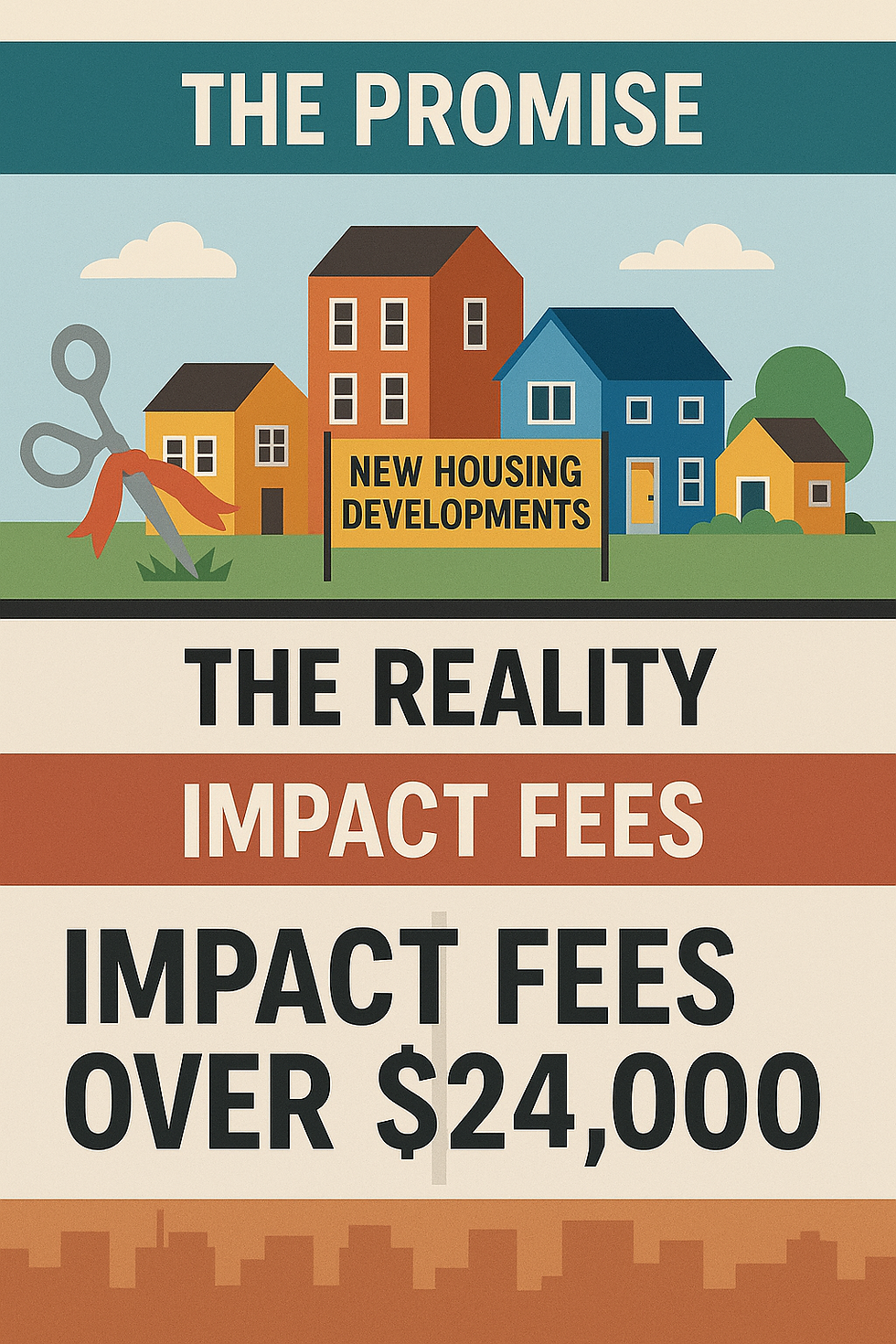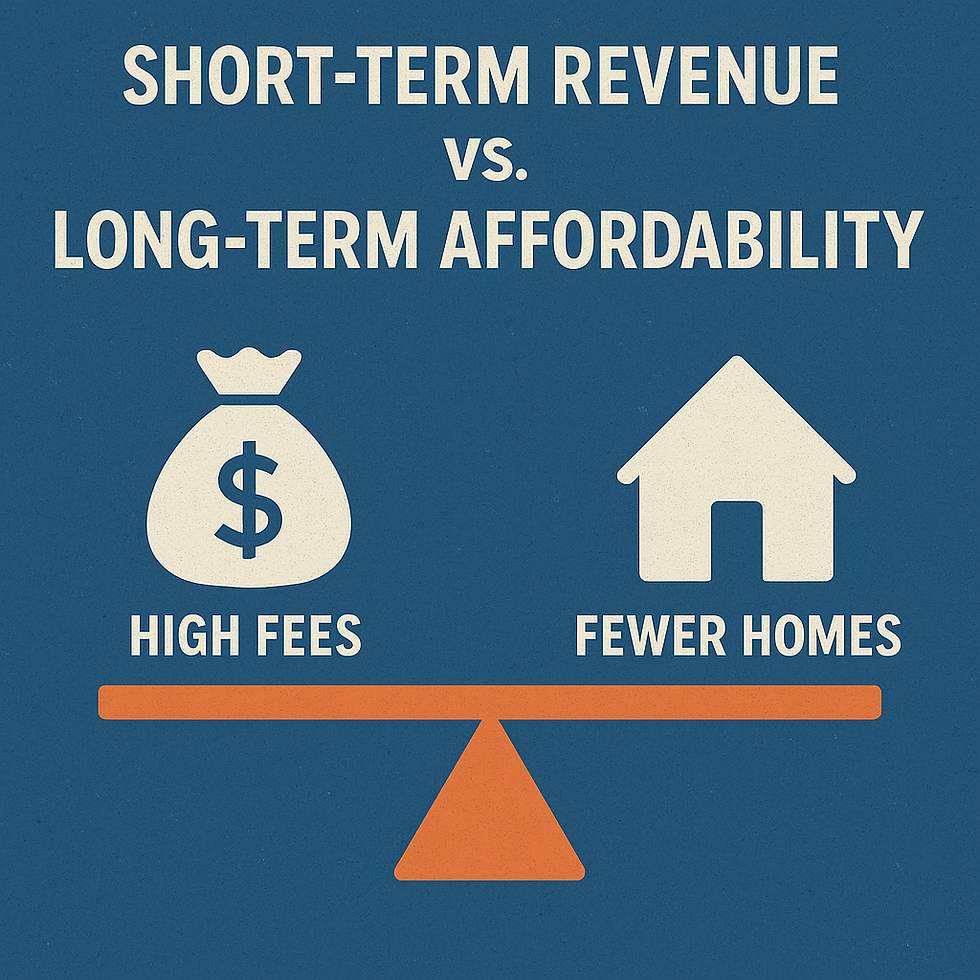The Hidden Costs Killing 'Affordable Housing' What Your City Isn’t Telling You
- Nathan Gass
- May 16
- 4 min read
Updated: Jun 10

You've heard the promises: Cities are working to improve housing affordability. They’re making it easier to build more homes, including duplexes, accessory dwelling units (ADUs), and split lots. But here's what they don’t tell you: Even with new zoning laws, they keep the same high fees in place — impact fees, permit costs, and utility connection charges — all of which pile onto your project before any construction begins. Today, we’re exposing the hidden costs that make real affordability seem impossible. We’ll also ask the tough question policymakers often dodge: Are we really solving the housing crisis, or just pretending? Welcome to REAL ISSUES.
At first glance, it seems like positive change. Cities announce laws to allow different housing types like tiny homes, backyard cottages, and townhomes. They celebrate new developments with ribbon cuttings and tout a brighter future with more housing options.
However, if you take a closer look, a significant hurdle remains: the costs associated with building.
If the fees — the permits, the hidden charges — are still incredibly high, then simply allowing more types of housing doesn’t help. Because most people still can't afford to take advantage of these new opportunities.
Today, we will explore what policymakers are promising and the stark realities many people may not know about.
The Promise vs. The Reality

In recent years, you may have noticed many headlines claiming, "City Eliminates Single-Family Zoning!" and "New Rules Allow Backyard Cottages!" These seem like great steps toward affordable housing.
But the truth is that opening the door to more housing types doesn’t guarantee they will be affordable.
The high costs associated with building often stifle progress.
Take impact fees, for example. These charges are imposed by cities to help cover the public services that new developments will require, like roads and parks. While they aim to make new buildings contribute to community needs, these fees can skyrocket.
Consider this: A city may charge over $24,000 in impact fees for a residential unit. Instead of fostering affordable housing, these fees get passed on to future tenants or buyers, negating the benefits brought by new zoning laws.
Hidden Fees — The Real Game Changer

Let’s take a closer look at the hidden fees that burden potential housing developers.
Permit Costs
The first major hidden cost is permit fees, which can vary dramatically from one city to another but often take a big chunk of a housing project’s budget.
In many urban areas, it’s common for these costs to reach between $15,000 and $30,000 just to get approval to start building. In some cases, they can range anywhere from $30,000 to $100,000 before construction even begins. These fees can significantly delay projects, prolonging the time before affordable housing becomes available.
Utility Hook-Up Charges
Next are utility hook-up fees, which apply when developers connect their buildings to essential services, such as water, electricity, and sewer.
These costs can often surprise developers, easily reaching tens of thousands of dollars. Since these charges are fixed regardless of the building size, they hit smaller projects the hardest. For instance, an ADU might face similar utility fees as a larger multi-family building, discouraging developers from pursuing smaller, more affordable projects.
Other Not-So-Obvious Fees
We also need to consider other costs, like environmental evaluations, zoning adjustments, and compliance with construction design regulations. Each of these can add both time and expenses to a project, further pushing developers away from affordable housing choices.
These hidden fees create a bottleneck. With land acquisition already costly, additional expenses make the idea of building affordable housing feel nearly impossible for many developers.
The Bigger Picture: Short-Term Revenue vs. Long-Term Affordability

So, why do cities continue enforcing these costly fee structures?
Often, municipalities face financial challenges themselves and rely on these fees as a crucial revenue source. In turn, cities end up prioritizing immediate financial gains over long-term solutions for housing affordability.
This creates a vicious cycle: high fees lead to fewer affordable homes being constructed, which intensifies demand for housing solutions, causing further strain on the market.
While some property owners may initially benefit from these regulations, the wider community — especially those needing affordable housing — ultimately suffers.
What Needs to Change?
So, how can we break this cycle?
First, cities must reassess their fee structures. By reducing or waiving some fees for affordable housing projects, they can encourage developers to create more units, generating real opportunities for residents.
Additionally, simplifying the approval process could help reduce costly delays, enabling projects to move forward quickly.
Policy reforms that aim for long-term affordability rather than short-term profits should become a priority in city planning.
The Path Forward
As urban populations grow and the demand for affordable housing escalates, understanding these hidden costs is vital.
Cities may boast about reforms and reductions in bureaucracy. Still, unless they address the financial challenges developers face, we may be witnessing a mere illusion of progress rather than a true solution to the housing crisis.
To genuinely address housing affordability, we must shift our focus from simply allowing more types of homes to building a system that lowers the costs associated with creating those homes.
Let’s bring these discussions to light and work together toward a more sustainable and inclusive approach to housing affordability.



Comments